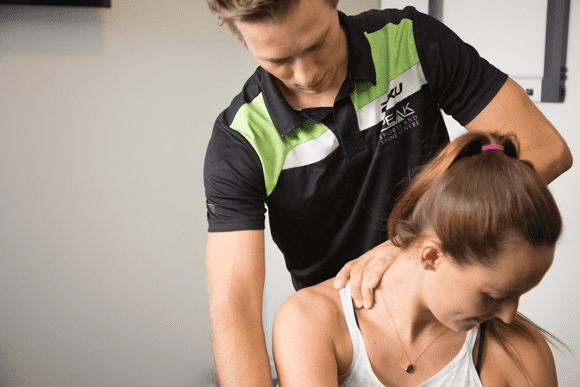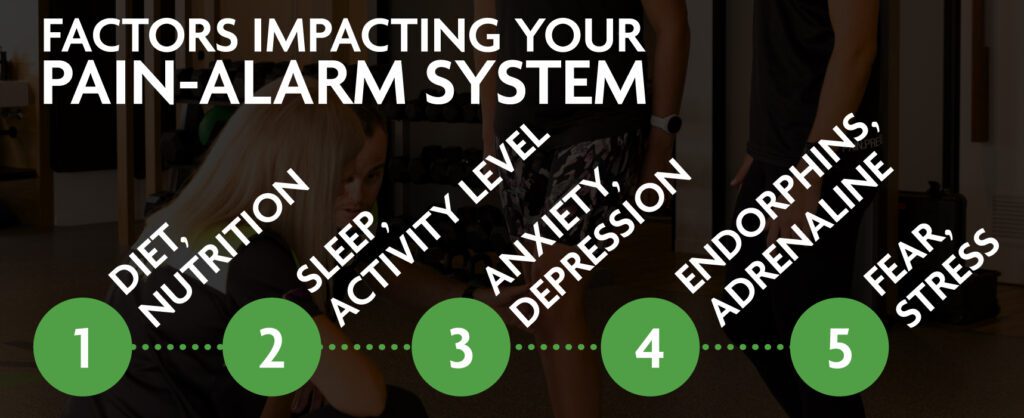
A biopsychosocial approach
Traditionally we have looked at pain through a biological lens. Focusing on tissue damage and repair. However, we have shifted our focus to looking at pain in terms of a biopsychosocial framework.
It is considering a dynamic, reciprocal and complex interaction of biological, psychological and social factors that influence pain.
Pain as a warning signal that can become heightened
Pain is a crucial signal that is essentially our brain’s way of telling us that we are potentially in danger or have experienced some form of tissue damage. If the brain is constantly sending pain signals to a specific area of the body, the nervous system can become hypersensitive over time. Almost as if the brain learns the pain.
Pain levels are also affected by a lot of different factors. High stress, poor nutrition and poor sleep have been proven to play a big role in having a heightened sense of pain. Even your own beliefs about pain can play a huge part in your perception and resilience to pain. An example of this would be if your mum grew up with a “bad back” all her life. Due to your experiences of her bad back, your own belief systems towards back pain may actually cause you to feel more back pain if a similar niggle arises compared to someone who had never witnessed back pain first hand.
An analogy often used to describe pain is that it is like a fire/smoke alarm—it can tell you there’s a fire in your house but it can’t explain the size of the fire and how threatening it is. It could be a birthday candle or it could be a genuine house fire. Pain is the same as that smoke alarm, your brain knows there has been potential harm but often due multiple factors your brain can amplify that sense of pain.
A plan to turn down your pain warning system
As practitioners, we regularly see this with athletes who have had back pain for months or even years from maybe a small fall or light motor-vehicle accident. When they come to see us at that later instance there is often no evidence of any major tissue damage with clinical testing or even on diagnostic scans—yet they are in REAL pain. With correct diagnostic testing to rule out anything dangerous, safe exercise progression, education and reassurance are used to help improve pain levels. If you are someone that suffers persistent pain, or has any questions about a condition, get in touch with us today to have a chat.
*Always consult your doctor for pain that is severe and/or unfamiliar.
Matthew Ross
Chiropractor and Coach
PEAK

A biopsychosocial approach
Traditionally we have looked at pain through a biological lens. Focusing on tissue damage and repair. However, we have shifted our focus to looking at pain in terms of a biopsychosocial framework.
It is considering a dynamic, reciprocal and complex interaction of biological, psychological and social factors that influence pain.
Pain as a warning signal that can become heightened
Pain is a crucial signal that is essentially our brain’s way of telling us that we are potentially in danger or have experienced some form of tissue damage. If the brain is constantly sending pain signals to a specific area of the body, the nervous system can become hypersensitive over time. Almost as if the brain learns the pain.
Pain levels are also affected by a lot of different factors. High stress, poor nutrition and poor sleep have been proven to play a big role in having a heightened sense of pain. Even your own beliefs about pain can play a huge part in your perception and resilience to pain. An example of this would be if your mum grew up with a “bad back” all her life. Due to your experiences of her bad back, your own belief systems towards back pain may actually cause you to feel more back pain if a similar niggle arises compared to someone who had never witnessed back pain first hand.
An analogy often used to describe pain is that it is like a fire/smoke alarm—it can tell you there’s a fire in your house but it can’t explain the size of the fire and how threatening it is. It could be a birthday candle or it could be a genuine house fire. Pain is the same as that smoke alarm, your brain knows there has been potential harm but often due multiple factors your brain can amplify that sense of pain.
A plan to turn down your pain warning system
As practitioners, we regularly see this with athletes who have had back pain for months or even years from maybe a small fall or light motor-vehicle accident. When they come to see us at that later instance there is often no evidence of any major tissue damage with clinical testing or even on diagnostic scans—yet they are in REAL pain. With correct diagnostic testing to rule out anything dangerous, safe exercise progression, education and reassurance are used to help improve pain levels. If you are someone that suffers persistent pain, or has any questions about a condition, get in touch with us today to have a chat.
*Always consult your doctor for pain that is severe and/or unfamiliar.
Matthew Ross
Chiropractor and Coach
PEAK
Let's get started — How can we help?
Physiotherapy
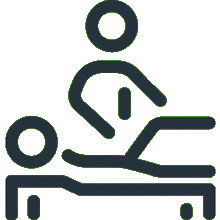
Chiropractic
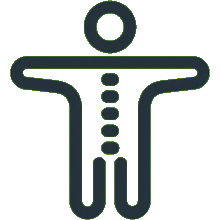
Podiatry
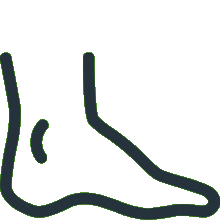
Massage Therapy
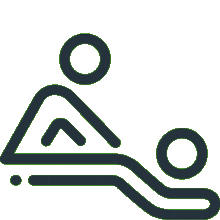
Women's Health Physiotherapy

Running Program Tailored To Your Goals
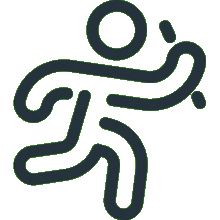
Joint Mobilisation

Active Release Technique
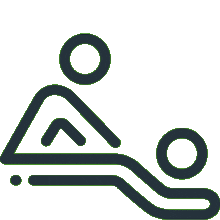
Exercise Prescription
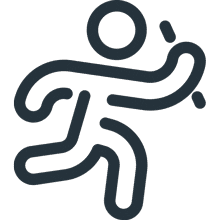
Real Time Ultrasound Imaging

Spinal Manipulation
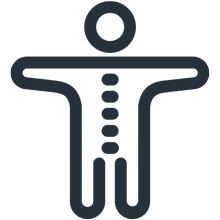
Functional Movement Screen
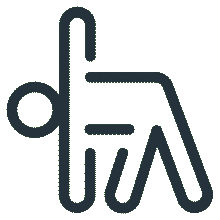
Knee Pain Treatment

Hamstring Strain Treatment
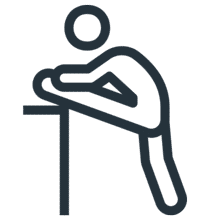
Hip Pain Treatment

Upper, Middle & Lower Back Pain

Neck Pain Treatment

Shoulder Pain & Rotator Cuff Tear

Can't find what you're after?
View all Services
Make an appointment
Or email the PEAK team at info@peakssc.com.au
Hawthorne
- Phone: (07) 3399 3318
- Fax: (07) 3319 6577
Address
5/171 Riding Road,Hawthorne, QLD, 4171 Get Directions
Opening Hours -
6 days per week
- Monday - Friday: 7:00 am - 8:00 pm
- Saturday: 7:00 am - 1:00 pm
To make a booking outside of business hours, please use our form by clicking here.
New Farm
- Phone: (07) 3399 4668
- Fax: (07) 3319 6577
Address
1/15 Lamington Street,New Farm, QLD, 4005 Get Directions
Opening Hours -
6 days per week
- Monday: 7:00 am - 8:00 pm
- Tuesday: 7:00 am - 8:00 pm
- Wednesday: 9:00 am - 8:00 pm
- Thursday: 10:00 am - 8:00 pm
- Friday: 7:00 am - 3:00 pm
- Saturday: 7:00 am - 3:00 pm
To make a booking outside of business hours, please use our form by clicking here.
